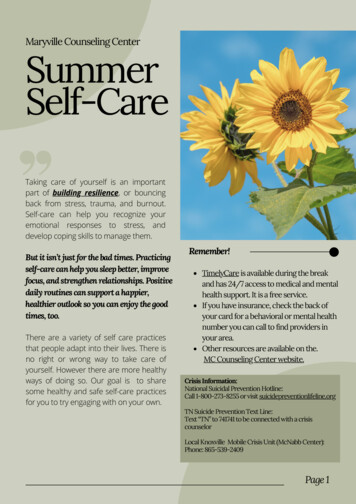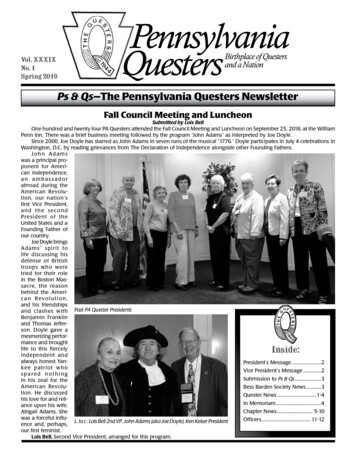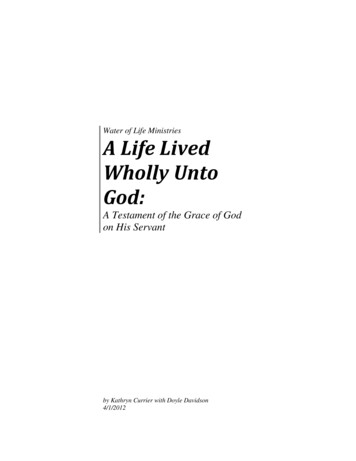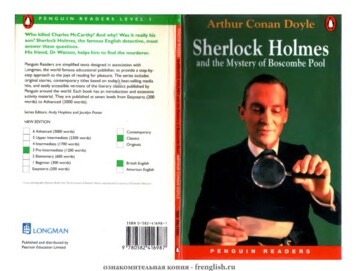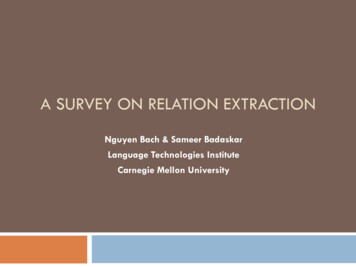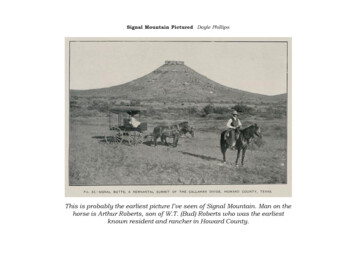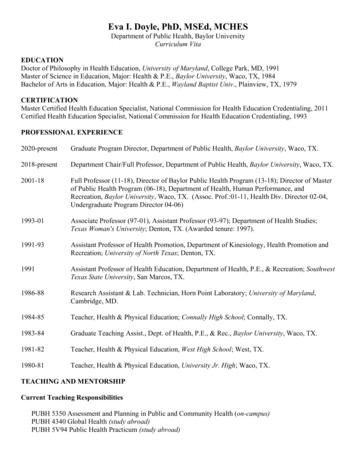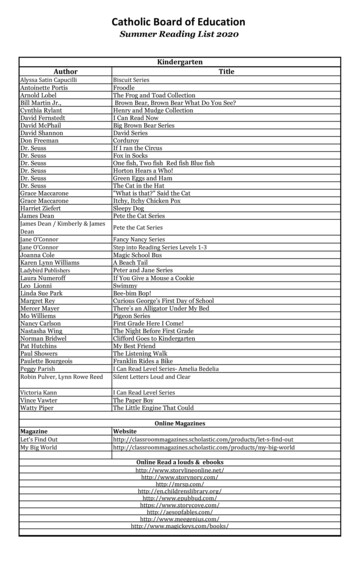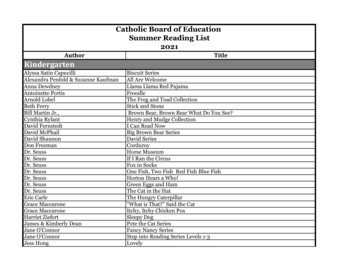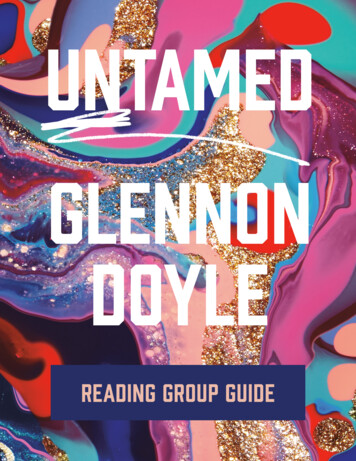
Transcription
UntamedGlennonDoyleREADING GROUP GUIDE1
PROLOGUE Glennon opens Untamed with the story of Tabitha, a caged cheetah sheencounters on a family trip to a safari park. Glennon watches Tabitha stalkthe periphery of the field where she’s kept captive and imagines Tabitha’sinner doubts, and her quick dismissal of those internal questions. Glennonimagines Tabitha saying to herself, “I should be grateful. I have a good enoughlife.” What does the phrase “good enough life” mean to you? Do you everfind yourself silencing your own inner voice? How does Tabitha symbolizeGlennon’s desire and journey to become “untamed”?PART 1: CAGED When Abby tells Glennon’s parents about her wish to marry their daughter,Glennon’s mother says, “I have not seen my daughter this alive since she wasten years old.” This prompts Glennon to ask: “Where did my spark go at ten?How had I lost myself?” She soon recognizes that at age ten, she began to letgo of her true self to be the “good girl” society expected her to be. She writes,“I was wild until I was tamed by shame.” How would you describe yourselfas a young child? Does a particular age in your childhood stand out as pivotalturning point for you? After meeting and falling in love with Abby, Glennon acknowledges thatcreating a life with her was the first original idea she’d had, and the firstdecision she made as a free woman. It forced her to question her faith,friendships, her work, her sexuality—her entire life. Have you ever askedyourself what you truly want, versus what you might be conditioned towant? Are there things you have denied yourself because they don’t “fit” withsociety’s expectations? Do you believe it’s possible to have what you reallywant despite a culture that might tell you otherwise? Glennon writes, “We forgot how to know when we learned how to please.”Does this feel true to you? Do you ever find yourself ignoring your owninstincts in favor of pleasing others? When? Why? Glennon describes her daughter Tish as “sensitive.” What does that mean?Glennon writes that Tish’s sensitivity is her “superpower.” In what ways doesher sensitivity make her powerful? In what ways could her sensitivity beperceived as inconvenient?2
Glennon writes that after she first discovered her husband’s infidelity, shedid not know whether they should get a divorce or try to reconcile. When shesays that she does not know what to do, the counselor at her children’s schooltells her, “You need to figure out how to know.” What are the ways our culturetells us “to know” things? Do you trust those methods of knowing? How doyou “figure out how to know”?PART 2: KEYS Glennon describes building a life of her own by “resurrecting the very partsof [herself she] was trained to mistrust”: her emotions, her intuition, herimagination, her courage. According to Glennon, “those are who we are.”What makes you who you are? Glennon says that the first time she saw Abby, she heard three words: “ThereShe Is.” At first Glennon thought those words had come to her from on high,but later she realizes they came from within. The voice she heard that daywas her own, telling her “Here I Am. I’m Taking Over Now.” When has yourinner voice allowed you to make important decisions? Describe how that felt. Glennon recalls that after her first AA meeting, a woman shared someinvaluable wisdom with her: “Feelings are for feeling. All of them. Even thehard ones.” Glennon remembers being surprised. She writes, “I did not knowthat I was supposed to feel everything. I thought I was supposed to feelhappy.” What feelings do you think we are supposed to feel? What feelingsdoes our culture tell us are inconvenient or inappropriate? Do you find itdifficult to let yourself “feel everything”? In “Know,” Glennon describes learning to connect to her inner Knowing. Shesays that each of us may call this Knowing something different, but that we allhave this inner wisdom. She writes, “Why do we worry about what to call theKnowing, instead of sharing with each other how to call the Knowing”? Howdo you call your Knowing? What does connecting to it feel and look like toyou? In “Imagine,” Glennon says that there is an “unseen order inside us” and thatit is “the vision we carry in our imagination about a truer, more beautifulworld.” Can you relate to this idea? Have you ever felt a “hopeful swelling”inside you “insisting that it was all meant to be more beautiful than this”?When? What did that feeling prompt you to do?3
PART 3: FREE Glennon describes living with “the Ache” starting at age ten. For many yearsshe believed the Ache was a reminder of death; the Ache says, “This ends,so leave.” Later, Glennon learns that the Ache might offer a different sort ofwisdom. What sort of wisdom might that be? What benefits does Glennonexperience from listening to the Ache? Glennon describes befriending Elizabeth Gilbert and discovering “anew friendship memo”—one with “no arbitrary rules or obligations orexpectations.” Discuss the friendships in your life. In what ways do theyoperate by “arbitrary rules”? How do those rules serve you and your friends?If you were to rewrite the rules of some of your friendships, what would thenew rules be? Glennon writes that “the end goal of every patriarchal culture is to convincewomen to control themselves.” What messages have you received from yourculture—messages from parents, friends, childhood stories, advertisers,religious groups, and politicians—that try to convince you to controlyourself? Glennon recognizes that her daughter Tish is very much like her, from thetime Tish was a baby. Once she realizes that being pressured to act happy iswhat made her sick as a teenager and young adult, Glennon stops pushingTish to “be pleasant.” Discuss how Glennon’s attitude about her role as Tish’smother changes, from when she is “Caged” to when she is “Free.” Glennon recalls watching a nature survival show and learning about a TouchTree, which is “a recognizable, strong, large tree that becomes the lost one’shome base.” What does this metaphor of a Touch Tree mean to you? WhenGlennon says, “I am not the woods. I am my own tree,” what does she mean? In “Boys,” Glennon describes some of the ways men are put “in cages” bycultural expectations. Do you agree with her assessment? What societalmessages can you think of that promote particular conceptions ofmasculinity? Glennon describes her process of “unlearning the whitewashed version ofAmerican history” and beginning to “really listen and think more deeplyabout the experiences of people of color and other marginalized people” as4
being similar to getting sober from addiction. What do you think about thatcomparison? In what ways does Glennon’s “waking up to white supremacy”reflect her path to sobriety? Glennon writes that “while choosing joy makes it easier for me to love myselfand my life, it seems to make it harder for the world to love me” and sheobserves that we “proclaim: Women are entitled to take their rightful place!Then, when a woman does take her rightful place, our first reaction is: She’sso . . . entitled.” Do you agree with this observation? Why do you think it isoften easier to like a woman when she is struggling, when she admits to being“a mess”? Why are we often discomfited by seeing a woman thrive? In “Streams,” Glennon describes starting Together Rising, the nonprofitcharitable organization she founded with a commitment to serving families inneed. Not long after becoming a philanthropist, Glennon became an activist.She writes that if we do not combine philanthropy with activism, we “riskbecoming codependent with power.” What does Glennon mean by that? Canyou list examples that prove this to be true? Glennon compares hard feelings—anger, heartbreak, and grief—to thedelivery of a package containing new information about herself. She writesthat the “reward for enduring hard feelings [is] finding [her] potential, [her]purpose, and [her] people.” What have you learned about yourself throughhardship? Glennon says that heartbreak is “magic” and that “the thing that breaks yourheart is the very thing you were born to heal.” What breaks your heart? Whatdoes that heartbreak reveal to you about meaningful work, activism, oropportunities for volunteering? In “Invaders,” Glennon makes a list of “easy buttons” and “reset buttons.”These are things she does when she is feeling anxious or depressed. The easybuttons (boozing, bingeing, shopping, etc.) allow her to abandon herself; thereset buttons (drinking a glass of water, taking a walk, meditating, etc.) returnher to herself. What are your easy and reset buttons? Glennon says that “to live a life of her own, each woman must answer: Whatdo I love? What makes me come alive? What is beauty to me and how do Itake time to fill up with it?” Answer those questions for yourself; discuss whatyou love and how you prioritize it in your own life.5
In “Seconds,” Glennon describes “unlearning what [she] used to believe aboutcontrol and love.” How and why do you think we often confuse control andlove? Can you think of times you have tried to control people, or times youhave felt others have tried to control you? In any of those situations, has thatcontrol been perceived as love? Why or why not? Glennon writes that the truth of her thirties was: “Stay on your mat, Glennon.The staying is making you.” And that the truth of her forties is: “I’m made.”What did she learn in that decade? Can you look at different periods of yourown life and identify phases of growth? How did they change you? Do youfeel “made”? Why or why not? Throughout Untamed, Glennon returns to the image of water and metaphorsof fluidity. She says that “Love is a river;” “Faith is water. Sexuality is water;”and “You are the sea.” Why do you think this water imagery is so important toGlennon? What does she mean by “stay fluid”? Throughout Untamed, Glennon shares a story or an idea and then returns toit again later in the book, from a new perspective. For example, please see thechapters titled “Apples” and “Beach Houses;” “Directions” and “Boys;” and“Algorithms,” “Mirrors,” and “Eyes.” How does the way Glennon shares theseanecdotes evolve? What new perspective does she bring to these stories whenshe returns to them?ENHANCE YOUR BOOK CLUB In the opening pages of Untamed, Glennon asks herself, “Who was I before Ibecame who the world told me to be?” Have everyone in your book club bringa photograph of themselves that they feel captures their original and wild self.When they share the photo with the group, have them explain what about thepicture captures them looking “Untamed.” In the “Imagine” section of Part II, Glennon recalls asking women to writea letter describing “the truest, most beautiful” lives they could imagine.Have your book club take some time in silence during which you all writeyourselves letters. In those letters, describe the truest, most beautiful lives/families/friendships/relationships you can imagine. Let your imagination gowild, do not edit yourself. What do you feel when you read the letter you’vewritten?6
Untame your social media feed. Glennon has said that “the Untamed arethose who quit spending their lives striving to be what they are ‘supposed’to be and decide instead to just be who they already are.” She believesthat Untaming doesn’t just happen, it is an ongoing, intentional process ofclearing our own air so we can breathe again. Begin by clearing the air onyour social media feed. To do this, unfollow the accounts that make you feelbad about yourself. Prioritize the accounts that make you feel brave andjoyful. Keep only accounts in your social media feed that remind you thateverything you need is already inside you. Glennon describes a snow globe she kept on a shelf in her childhoodbedroom. She writes, “In its center stood a red dragon with sparkly scales.”She later says, “We’re like snow globes: We spend all our time, energy,words, and money creating a flurry . . . making sure the snow doesn’t settleso we never have to face the fiery truth inside us.” Do you identify with theidea of a dragon of truth inside of you? What do you do to “create a flurry” todistract yourself and others from that dragon inside? On one side of a pieceof paper, list the ways you “create flurries” in your own life. On the otherside of that same paper, can you list ways you let the snow settle? Whatdoes looking at those lists reveal to you? Get involved with Together Rising, the 501(c)(3) nonprofit that Glennonfounded in 2012. Together Rising has raised more than 25 million forpeople in need with a most frequent donation of 25, proving that small giftscan change the world in revolutionary ways. Visit togetherrising.org tolearn more, donate, or volunteer.7
ENHANCE YOUR BOOK CLUB In the opening pages of Untamed, Glennon asks herself, “Who was I before I became who the world told me to be?” Have everyone in your book club bring a photograph of themselves that they feel captures their original and wild self. When they share t
